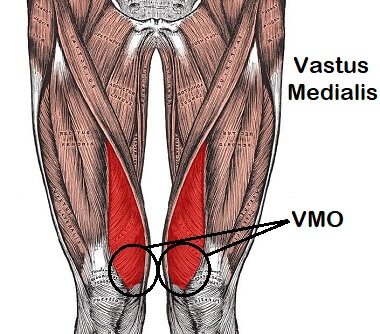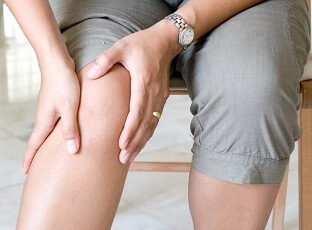- Home
- Knee Joint Anatomy
- Knee Muscles
- Quadriceps
- Vastus Medialis
Vastus Medialis Muscle
Written By: Chloe Wilson, BSc(Hons) Physiotherapy
Reviewed by: KPE Medical Review Board

The vastus medialis muscle is the most medial of the quadriceps muscles, found on the inner side of the front of the thigh.
Vastus medalis works with the other quadriceps to straighten the knee.
It is particularly important as the lower fibers attach to the inner side of the kneecap, controlling it's position.
Weakness and tightness in the vastus medialis muscles is a common cause of knee pain and can affect activities such as walking, running and jumping.
Here we will look at the anatomy and function of the vastus medialis muscle, how to strengthen it and common problems affecting the muscle.
Origin & Insertion
The vastus medialis muscle has an extensive origin on the anteromedial surface of the femur (thigh bone) which begins at lower medial end of the intertrochanteric line, runs down around the medial aspect of the spiral line and the medial lip of the linea aspera.

It continues on to the upper two thirds of the medial supracondylar line, medial intermuscular septum and the adductor magnus tendon.
The upper fibres, often referred to as Vastus Medialis longus, mainly pass straight downwards whereas the lower fibres, often referred to as Vastus Medialis Oblique, pass forwards, almost horizontally.
The muscle fibres join with one of the other quadriceps muscles, rectus femoris, the medial border or the kneecap and the medial condyle of the tibia, fusing with the deep fascia and replacing the lateral joint capsule.
The fibres that join with the other quadriceps muscles surround the patella and attach to the tibial tuberosity on the front of the tibia (shin bone) just below the kneecap via the patella tendon.
Vastus Medialis Function
Vastus Medialis works with the other quadriceps muscles to straighten the knee. It is particularly important as it helps the knee joint to lock in the final stages of knee extension as the femur rotates medially.
The portion of muscle just above the kneecap is often referred to as vastus medialis oblique or VMO. There is some debate as to whether the VMO is anatomically and functionally distinct from the rest of the muscle or just a part of the muscle.
The VMO plays an important role in stability particularly of the kneecap by resisting the tendency for the patella to move laterally (outwards) due to the femoral angulation and reducing the risk of kneecap dislocation.
In some cases, usually following an injury or due to biomechanics, vastus medialis oblique can become weak, fatigued, mis-fire or switch off altogether. This can lead to problems with patella tracking (how the kneecap moves) and anterior knee pain such as patellofemoral pain syndrome.
Vastus Medialis as a whole works with the other quadriceps muscles to straighten the knee, all working strongly through their entire range. They work in activities such as standing up from a seated or kneeling position, going up and down stairs, cycling and squatting.
Weakness in the vastus medialis muscle can lead to a whole host of knee problems including:
- Patellofemoral Pain Syndrome: aka Runners Knee. Causes front knee pain
- Quadriceps Tendonitis: Causes pain and swelling above the knee
- Patellar Tendonitis: Causes pain and swelling below the knee
- Chondromalacia Patella: Causes anterior knee pain
- Knee Bursitis: Can cause pain and pockets of swelling anywhere around the knee depending on which bursa is affected
How To Strengthen Vastus Medialis

Weakness in vastus medialis, particularly the VMO, is a common cause of knee pain and instability and puts you at greater risk of kneecap dislocation.
Weakness in the vastus medialis muscle can lead to patellar tracking problems when walking, running and jumping and is a very common cause of knee pain.
But there are simple vastus medialis exercises that you can do to both strengthen and stretch the muscle and target the VMO. Most people with knee problems would benefit from doing VMO exercises.
Common Vastus Medialis Problems
Common problems associated with the vastus medialis muscle are:
- Muscle Imbalance: weakness and/or tightness in vastus medialis can lead to medial knee pain
- Kneecap Problems: weakness in the vastus medialis oblique portion of the muscle can affect the positioning and movement of the knee cap which frequently results in kneecap pain
- Muscle Strain: sudden over-loading or over-stretching of the vastus medialis muscle can lead to quads strain
If you are suffering from knee pain due to vastus medialis problems you may be interested in:
- Quadricep Stretches: How to tell if you would benefit from stretches and easy to follow video guides
- Vastus Medialis Strengthening: Exercises that specifically target vastus medialis and the VMO
- Knee Strengthening: How to strengthen the quads and other knee muscles
- Knee Muscles: Learn about the different muscles that control the knee and how they work together
- Common Knee Injuries: Find out everything you need to know about the most common knee injuries and how to treat them
Vastus Medialis Summary
Muscle Group: Vastus Medialis muscle is part of the Quadriceps
Action: Extends (straightens) the knee
Origin: Large portion of the anteromedial aspect of the femur
Insertion: Medial border of the patella (joins with the other quads tendons), medial condyle of the tibia and the tibial tuberosity via the patella tendon
Nerve Supply: Femoral nerve (L2, L3, L4)
Special Function: Knee and kneecap stability especially in the final stage of knee extension
AKA: Vastus Internus, Vastus Medialis Oblique, VMO, teardrop muscle
You might also be interested in the following articles:
- Knee Pain & Popping
- Swollen Knee Treatment
- Front Knee Pain
- Side Knee Pain
- Burning Knee Pain
- Knee Range Of Motion
- Knee Pain On Stairs
Other Knee Muscles
Page Last Updated: 25/05/23
Next Review Due: 25/05/25





